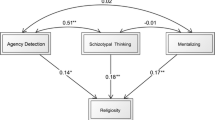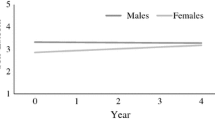Abstract
Religiousness generally favors self-control and is associated with fewer occurrences of impulsive behavior. Religions often favor delayed rewards as this factor is directly linked to religious principles and dogma. We aimed to analyze the possible association between religiosity, impulsivity, and delayed gratification in Brazilian adults. The study sample consisted of 538 adults evaluated using instruments validated for virtual platform administration through which aspects such as religiosity, impulsiveness, delayed gratification, mental health, personality, and socioeconomic conditions were assessed. We determined the associations among variables through Pearson correlation and regression analysis and found significant correlations between general impulsivity and organized religiosity, nonorganized religiosity, and intrinsic religiosity. We also found significant but weak correlations between gratification delay and religiosity categories. The results of our study suggest that people who are more religious are generally less impulsive and more capable of delaying gratification, although it is a slight correlation. Some mechanisms by which religiosity might be connected to self-control are discussed.
Similar content being viewed by others
References
Ano, G. G., & Vasconcelles, E. B. (2005). Religious coping and psychological adjustment to stress: A meta-analysis. Journal of Clinical Psychology, 61(4), 461–480. https://doi.org/10.1002/jclp.20049
Araújo, M. M., Malloy-Diniz, L. F., & Rocha, F. L. (2009). Impulsividade e acidentes de trânsito [Impulsivity and traffic accidents]. Archives of Clinical Psychiatry (são Paulo), 36(2), 60–68.
Baier, C. J., & Wright, B. R. E. (2001). “If you love me, keep my commandments”: A meta-analysis of the effect of religion on crime. Journal of Research in Crime and Delinquency, 38(1), 3–21.
Bari, A., & Robbins, T. W. (2013). Inhibition and impulsivity: Behavioral and neural basis of response control. Progress in Neurobiology, 108, 44–79.
Barratt, E. S. (1959). Anxiety and impulsiveness related to psychomotor efficiency. Perceptual and Motor Skills, 9(3), 191–198.
Baumeister, R. F., & Vohs, K. D. (2004). Self-regulation. In C. Peterson & M. E. P. Seligman (Eds.), Character strengths and virtues: A handbook and classification (pp. 499–516). American Psychological Association / Oxford Press.
Bloom, P. (2012). Religion, morality, evolution. Annual Review of Psychology, 63(1), 179–199.
Caribé, A. C., Rocha, M. F. V., Junior, D. F. M., Studart, P., Quarantini, L. C., Guerreiro, N., & Miranda-Scippa, Â. (2015). Religiosity and impulsivity in mental health. Journal of Nervous & Mental Disease, 203(7), 551–554.
Carvalho, L. F., & Primi, R. (2008). Versão brasileira do Ten-Item Personality Inventory TIPI-Br. Instrumento não publicado.
de Paula, J. J. (2017). Religiosity is a moderator of the relationship between impulsivity and internalizing symptoms. Archives of Clinical Psychiatry (são Paulo), 44(1), 20–22.
De Paula, J. J., Costa, D. S., Oliveira, F., Alves, J. O., Passos, L. R., & Malloy-Diniz, L. F. (2015). Impulsivity and compulsive buying are associated in a non-clinical sample: Evidence for the compulsivity-impulsivity continuum? Brazilian Journal of Psychiatry, 37(3), 242–244.
De Paula, J. J., de Souza Costa, D., de Miranda, D. M., & Romano-Silva, M. A. (2020). The abbreviated version of the Barratt Impulsiveness Scale (ABIS): Psychometric analysis, reliable change indexes in clinical practice and normative data. Psychiatry Research, 291, Article 113120.
De Paula, J. J., Porto, A. A., & de Souza Costa, D. (2018). Brazilian version of the Delaying Gratification Inventory (DGI): Transcultural adaptation, evidences of validity and reliability. Revista Interdisciplinar Ciencias Médicas, 2(2), 29–35.
Duckworth, A. L., & Seligman, M. E. P. (2005). Self-discipline outdoes IQ in predicting academic performance of adolescents. Psychological Science, 16(12), 939–944.
Esperandio, M. R. G., & Marques, L. F. (2014). The psychology of religion in Brazil. International Journal for the Psychology of Religion, 25(4), 255–271.
Fingelkurts, A. A., & Fingelkurts, A. A. (2009). Is our brain hardwired to produce God, or is our brain hardwired to perceive God? A systematic review on the role of the brain in mediating religious experience. Cognitive Processing, 10(4), 293–326.
Ghandour, L. A., & El Sayed, D. S. (2013). Gambling behaviors among university youth: Does one’s religious affiliation and level of religiosity play a role? Psychology of Addictive Behaviors: Journal of the Society of Psychologists in Addictive Behaviors, 27(1), 279–286.
Gomes, F. C., de Andrade, A. G., Izbicki, R., Moreira Almeida, A., & Oliveira, L. G. (2013). Religion as a protective factor against drug use among Brazilian university students: A national survey. Revista Brasileira De Psiquiatria, 35(1), 29–37.
Gosling, S. D., Rentfrow, P. J., & Swann, W. B. (2003). A very brief measure of the Big-Five personality domains. Journal of Research in Personality, 37(6), 504–528.
Harding, T. W., De Arango, M. V., Baltazar, J., Climent, C. E., Ibrahim, H. H. A., Ladrido-Ignacio, L., & Wig, N. N. (1980). Mental disorders in primary health care: A study of their frequency and diagnosis in four developing countries. Psychological Medicine, 10(2), 231–241.
Hill, T. D., Burdette, A. M., Ellison, C. G., & Musick, M. A. (2006). Religious attendance and the health behaviors of Texas adults. Preventive Medicine, 42(4), 309–312.
Hoerger, M., Quirk, S. W., & Weed, N. C. (2011). Development and validation of the Delaying Gratification Inventory. Psychological Assessment, 23(3), 725–738.
Instituto Brasileiro de Geografia e Estatística [IBGE]. (2010). Censo Brasileiro de 2010. https://www.ibge.gov.br/estatisticas/sociais/populacao/9662-censo-demografico-2010.html?edicao=9749t&t=destaques
Joiner, T. E., Perez, M., & Walker, R. L. (2002). Playing devil’s advocate: Why not conclude that the relation of religiosity to mental health reduces to mundane mediators? Psychological Inquiry, 13(3), 214–216.
Kapogiannis, D., Barbey, A. K., Su, M., Zamboni, G., Krueger, F., & Grafman, J. (2009). Cognitive and neural foundations of religious belief. Proceedings of the National Academy of Sciences, 106(12), 4876–4881.
Koenig, H. G., Meador, K., & Parkerson, G. (1997). Religion Index for Psychiatric Research: A 5-item measure for use in health outcomes studies. American Journal of Psychiatry, 154, 885–886.
Lodi-Smith, J., & Roberts, B. W. (2007). Social investment and personality: A meta-analysis of the relationship of personality traits to investment in work, family, religion, and volunteerism. Personality and Social Psychology Review, 11(1), 68–86.
Malloy-Diniz, L. F. (2008). Association between impulsive phenotype and the functional 5HTTLPR polymorphism in adults with Attention Deficit Hyperactivity Disorder (ADHD). Unpublished doctoral dissertation. Universidade Federal de Minas Gerais, Belo Horizonte, MG, Brasil.
McCullough, M. E., & Boker, S. M. (2007). Dynamical modeling for studying self-regulatory processes: An example from the study of religious development over the life span. In A. D. Ong & M. V. Dulmen (Eds.), Handbook of methods in positive psychology (pp. 380–394). Oxford University Press.
McCullough, M. E., Hoyt, W. T., Larson, D. B., Koenig, H. G., & Thoresen, C. E. (2000). Religious involvement and mortality: A meta-analytic review. Health Psychology, 19(3), 211–222.
McCullough, M. E., & Willoughby, B. L. B. (2009). Religion, self-regulation, and self-control: Associations, explanations, and implications. Psychological Bulletin, 135(1), 69–93.
Moeller, F. G., Barratt, E. S., Dougherty, D. M., Schmitz, J. M., & Swann, A. (2001). Psychiatric aspects of impulsivity. American Journal of Psychiatry, 158(11), 1783–1793.
Moreira-Almeida, A., Peres, M. F., Aloe, F., Neto, L. F., & Koenig, H. G. (2008). Versão em português da Escala de Religiosidade da Duke: DUREL. Archives of Clinical Psychiatry (são Paulo), 35(1), 31–32.
Neri, M. C., & de Melo, L. C. C. (2011). Novo mapa das religiões [New map of religions]. Horizonte, 9(23), 637–673.
Noël, X., Brevers, D., & Bechara, A. (2013). A triadic neurocognitive approach to addiction for clinical interventions. Frontiers in Psychiatry, 4, Article 179.
Pargament, K. I. (1997). The psychology of religion and coping. Guilford Press.
Park, C. L. (2007). Religiousness/spirituality and health: A meaning systems perspective. Journal of Behavioral Medicine, 30(4), 319–328.
Patton, J. H., Stanford, M. S., & Barratt, E. S. (1995). Factor structure of the Barratt Impulsiveness Scale. Journal of Clinical Psychology, 51(6), 768–774.
Powell, L. H., Shahabi, L., & Thoresen, C. E. (2003). Religion and spirituality: Linkages to physical health. American Psychologist, 58(1), 36–52.
Saroglou, V. (2002). Religion and the five factors of personality: A meta-analytic review. Personality and Individual Differences, 32(1), 15–25.
Seybold, K. S. (2007). Physiological mechanisms involved in religiosity/spirituality and health. Journal of Behavioral Medicine, 30(4), 303–309.
Silva, M. D. S., & Zanello, V. M. (2010). Religiosidade e loucura: A influência da religião na forma como o “doente mental” enfrenta a doença [Religiosity and madness: The influence of religion in the way the “mentally ill” face the disease]. Psicologia IESB, 2(1), 37–47.
Strawbridge, W. J., Shema, S. J., Cohen, R. D., & Kaplan, G. A. (2001). Religious attendance increases survival by improving and maintaining good health behaviors, mental health, and social relationships. Annals of Behavioral Medicine, 23(1), 68–74.
Stroppa, A., & Moreira-Almeida, A. (2008). Religiosity and health. In M. I. Salgado, & G. Freire (Eds.), Health and spirituality: A new vision of medicine (pp. 427–443). Belo Horizonte: Inede.
Tangney, J. P., Baumeister, R. F., & Boone, A. L. (2004). High self-control predicts good adjustment, less pathology, better grades, and interpersonal success. Journal of Personality, 72(2), 271–324.
Taunay, T. C. D. E., Gondim, F. D. A. A., Macêdo, D. S., Moreira-Almeida, A., Gurgel, L. D. A., Andrade, L. M. S., & Carvalho, A. F. (2012). Validação da versão brasileira da escala de religiosidade de Duke (DUREL). Archives of Clinical Psychiatry (são Paulo), 39, 130–135.
Uyanık, G. K., & Güler, N. (2013). A study on multiple linear regression analysis. Procedia-Social and Behavioral Sciences, 106, 234–240.
Vasconcelos, A. G. (2012). Adaptação cultural e investigação das propriedades psicométricas da Barratt Impulsiveness Scale (BIS-11). [Unpublished doctoral dissertation]. Universidade Federal de Minas Gerais.
Acknowledgements
AAP received a Scholarship from the Fundação de Amparo à Pesquisa de Minas Gerais.
Author information
Authors and Affiliations
Corresponding author
Ethics declarations
Conflict of Interest
The authors declare that they have no known competing financial interests or personal relationships that influenced the work reported in this paper.
Additional information
Publisher's Note
Springer Nature remains neutral with regard to jurisdictional claims in published maps and institutional affiliations.
Rights and permissions
Springer Nature or its licensor (e.g. a society or other partner) holds exclusive rights to this article under a publishing agreement with the author(s) or other rightsholder(s); author self-archiving of the accepted manuscript version of this article is solely governed by the terms of such publishing agreement and applicable law.
About this article
Cite this article
Porto, A.A., Di Fini, B.C., da Silva, L.G. et al. Relationships Among Religiosity, Impulsivity, and Delayed Gratification in Brazilian Adults. Pastoral Psychol 73, 271–281 (2024). https://doi.org/10.1007/s11089-023-01096-6
Accepted:
Published:
Issue Date:
DOI: https://doi.org/10.1007/s11089-023-01096-6




